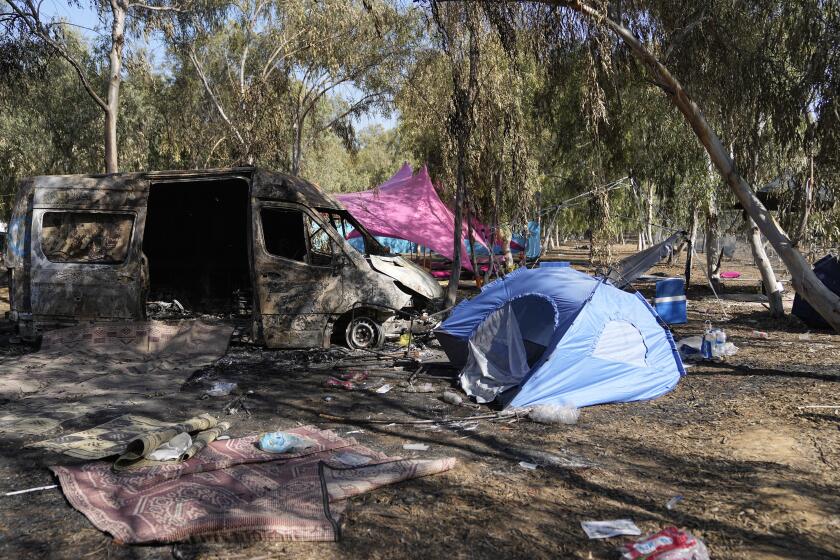Look Homeward, Angels : Salvadoran Refugees in L.A. Have Joined Forces to Help Rebuild Their War-Torn Homeland. Through Fund-Raising Efforts Here, They Have Rebuilt Schools and Churches, Paved Damaged Roads and Provided Medical Supplies
FRANCISCO AYALA BUFFED THE freshly waxed surface of the ambulance one last time, then stood back to admire the gleaming red results. The letters on the side stood out clearly: “ Unidad de Salud de Estanzuelas, Departamento de Usulutan ,” the name of the health clinic in a small town nestled in the mountains of eastern El Salvador.
Ayala grew up in Estanzuelas, but fled to escape the country’s bloody civil war that killed 75,000 people and made refugees of 1 million more, half of whom settled in Los Angeles. With peace restored, Ayala and thousands of other Salvadorans have united to help heal their ravaged country from afar, one town at a time.
“They have asked us to send the ambulance over as soon as possible,” said Ayala’s cousin, Julia Zelaya, who heads the Club Pro-Estanzuelas de Los Angeles, a group of former Estanzuelan neighbors who formed a hometown association a year and a half ago.
“A lot of people have died because they couldn’t get to medical care in time, and we want to save those lives.”
Soon, the ambulance will leave the garage of Ayala’s East Hollywood apartment building on its 5,000-mile journey to the impoverished town of 20,000 that sits miles of rough roads from the nearest hospital.
The used vehicle cost $6,000, money that Club Pro-Estanzuelas spent a year raising. A recent dance netted $1,500, more than enough to pay a driver to make the long trek through Mexico and Central America.
The Estanzuelas group is one of about 40 hometown associations of Salvadoran refugees throughout Los Angeles. Although many immigrant groups have launched similar efforts over the years, the special sense of unity and creativity that accompanies the Salvadorans’ work reflects the urgency of their mission to resurrect a country devastated economically and emotionally by 12 years of war.
After a peace treaty ended the fighting in 1992, many refugees who had set down roots in Los Angeles reunited in exile and began to translate their concerns into tangible help.
Through word of mouth, the associations have established an international network of aid, calling on acquaintances throughout the country and anywhere else Salvadoran refugees reside to join their cause.
They work closely with friends and family members in El Salvador, compiling lists of needs. Money is raised by hosting dances, bus trips to Las Vegas and Laughlin, Nev., and through picnics and raffles. Even beauty pageants, held traditionally on the feast day of each town’s patron saint, have been transformed into fund-raisers: The young woman crowned queen is the one who raises the most money in pledges.
The associations have managed to rebuild schools and churches, pave damaged roads, build libraries and playgrounds, and provide hospitals and clinics with medicine, supplies and, as in the case of Club Pro-Estanzuelas de Los Angeles, ambulances.
The need to rebuild their hometowns and provide a better life for loved ones has kept Salvadoran refugees tied to their native country, even though they may no longer call it home.
“No one wants to go back, but we see the poverty there and want to help,” Zelaya said. “It’s gotten worse since the war. The people who can go to the store and buy groceries are able to do so because they have relatives here. We have the advantage of being here and working, so we can send things to them.”
For those on the receiving end in El Salvador, a hometown association in the United States means access to necessary aid and goods they could never hope to obtain on their own.
In Estanzuelas, Zelaya’s cousin, Carmen Maria Ayala, is the secretary of a local clinic improvement committee, which for the past two years has also raised funds to aid the poorly equipped facility. But in a town where residents can barely afford to fix the bullet holes and missing chunks of plaster that still scar their walls, the committee’s fund-raising efforts have been limited.
“We definitely need more help,” Ayala said in a phone interview. “We’re lucky if a raffle brings in 100 colones (about $11). We need an ambulance badly, because a lot of people don’t have any way of getting to the clinic, let alone a hospital in another town. Some of the poorest people from outside of town have to walk for several kilometers. We need everything here.”
*
The Estanzuelas clinic serves between 50 and 75 patients a day, with severely limited resources. Medicine provided by the government often arrives past its expiration date, so Zelaya personally brought down $500 last year to purchase new pharmaceuticals.
The ambulance will arrive stocked with medicine, ointments, bandages and other supplies, including donated wheelchairs and crutches.
It will be delivered to the clinic by driver Julio Herrera, a member of the Cacaopera hometown association, which shipped an ambulance to El Salvador last year by truck. Although Herrera did not make that trip, he has delivered other vehicles and is familiar with the route as well as with customs procedures.
Before Herrera sets off, Zelaya will try to obtain an import tax waiver through the Salvadoran consulate, which would save the association from having to pay up to 15% of the vehicle’s value in customs. The $1,000 fee paid Herrera will cover travel expenses and a flight back to Los Angeles.
Herrera has pledged to take special precautions every step of the way.
“A friend will accompany me in another vehicle, and we’ll make sure to find motels that have parking just outside the room,” he said. “If we can’t find one, we’ll sleep right in the ambulance.”
Delivering aid in person is typical of the way the hometown associations work. If something must be purchased or a project must be contracted in El Salvador, a member will travel there with funds and personally oversee the work. If an item is being sent, someone will usually accompany it down to make sure nothing goes wrong.
“We don’t want to kick ourselves in the teeth,” Zelaya said, looking out over the Ayalas’ balcony at the precious ambulance. “Our country is very corrupt. We’ve made our dream a reality here , and the last thing we want is for someone to destroy it for us there .”
The associations prefer to steer clear of politics and politicians altogether. They rarely channel money through municipal governments or contract a project from afar.
“Our community as a whole is not very trusting, given what we’ve been through,” explained Jaime Penante, president of COMUNIDADES (Comunidades Unificadas para la Asistencia Directa a El Salvador), a coalition of 31 associations based at the El Rescate refugee center in Pico-Union.
He added that association members “don’t want to see themselves involved with either the right or the left. Their primary objective is simply aiding our people and rebuilding our country.”
Those who have trusted government officials have sometimes paid dearly, Penante said. Early on, one association channeled funds for a children’s playground through the town’s mayor, only to have the mayor take control of the project and claim the completed playground as his own work and that of his political party.
*
Some groups have eliminated the need to send emissaries by forming sister associations of trusted friends and relatives back home. These people determine need, receive and disburse funds, hire contractors and oversee the completion of projects, then send receipts back as proof.
In the town of Tejutepeque, an agricultural center of 15,000 surrounded by rolling green hills about 35 miles north of the capital city of San Salvador, 70-year-old retired schoolteacher Amilcar Contreras Escobar keeps in close contact with his nephew, Edgar Escobar of Highland Park.
Amilcar heads the Comite Local de Tejutepecanos Unidos, a group of retirees and local farmers who serve as the Salvadoran counterparts to his nephew’s Tejutepecanos Unidos en Los Angeles.
Since 1992, the Los Angeles group has provided scholarships for poor teen-agers to attend Tejutepeque’s first high school, which opened just three years ago. They have also sent the school about 100 textbooks, 12 typewriters, school supplies and sports equipment.
“We study what is needed in the community,” said Amilcar Escobar. “We know the people here who have limited resources, families whose fathers were killed, or who abandoned them. Some children have both parents, but these people are very poor and can’t afford to send them to school. So when they get these scholarships, their parents tell us, ‘May God bless those people! They help us even though they are so far from home!’ ”
Needy parents who cannot afford the school’s annual tuition of 300 colones (about $34) often approach Principal Maria Guadalupe Rivas de Mejia, who turns to Escobar for help from Los Angeles.
“Without the scholarships, these young people would not be able to attend school,” Mejia said. “Many parents pull their children out after sixth grade (the compulsory minimum) because they cannot afford to send them any more, and (they) need them in the fields. Those people in Los Angeles have given us a great help, and we’re very grateful.”
The group’s most recent project involved installing a “ Bienvenidos, “ or “welcome” sign, at the edge of town. Another fund-raising dance enabled Edgar Escobar to send down $1,800 for 26 new scholarships, repair of the town’s bullet-pocked church clock tower and running water for the high school. Future fund-raisers aim to provide electricity for the school and pave the dirt road that leads into town.
Edgar Escobar has been busy expanding his network of former Tejutepecanos. The group numbers close to 400 in Los Angeles and has already invested an estimated $7,000 in its members’ hometown.
*
Last year, Escobar persuaded his two brothers in Toronto to make contacts there, resulting in a new Canadian association that plans to improve the town’s kindergarten. He is also trying to seek out some boyhood friends who he hears now live in Australia.
“With all of us working together, we can give our town a little more support,” Escobar said. “Our town was very badly affected by the war, and our people still suffer. Our objective is to rebuild the town and help it stay afloat.”
In addition to the dozens of hometown associations that exist in Los Angeles, there are several others in cities with large Salvadoran communities such as Washington, New York, San Francisco and Houston.
Although a few began forming in the late 1980s, it was the end of the war that signaled the birth of most of the associations active today.
“After the war, people who had legal status were able to come back and visit, and they were shocked by the living conditions after not having been here for a while,” said Katarina Eeckhoff, a researcher with the Fundacion Nacional Para El Desarrollo (National Development Fund) in San Salvador, who has studied hometown associations extensively. “Because the war was over, they felt more confident about making a social investment.”
As postwar unemployment has soared in El Salvador, so has financial aid to relatives from family members in the United States. This year, personal remittances--which long ago replaced coffee exports as the country’s single largest source of income--are expected to top $1 billion.
*
While remittances allow relatives back home to live better on a daily basis, many of the Salvadoran associations feel these regular injections of dollars do little to help their loved ones in the long run.
“Individual remittances to families are consumed, and have a way of creating dependency,” Penante said. “There are some people who do not look for work, because they’ve become so accustomed to waiting for their monthly check to arrive. This ends up hindering the development of the community.”
Dependent relatives may be dealt a blow after Sept. 30, when work permits for Salvadorans who have not obtained legal residence will expire. The federal government modified its usual policy for residence during the civil war because of the potential for grave harm if Salvadorans were forced to return home.
Immigration authorities and Salvadoran refugees do not expect a massive exodus, but remittances could dwindle as immigrant relatives are forced to go underground and accept under-the-table jobs for less pay.
The hometown associations could feel the effect of this belt-tightening. Although many active members have already achieved legal status and relative financial security, some of the associations’ thousands of ancillary members could be forced to skimp on donations, or may be too busy tending to legal matters to help raise funds.
Some hometown associations are trying to move beyond philanthropy by studying ways to make their hometowns more self-sufficient. Four associations are working with El Rescate’s Flor de Izote Foundation in El Salvador to study strategies for genuine economic development in their communities.
“We want to teach our people to be less dependent on their relatives here,” said Edgar Escobar, whose Tejutepeque group is participating in the study. “Since our town is agricultural, we’re thinking about maybe setting up some sort of dispensary where farmers can sell their crops. We need to make the people themselves participate in the town’s reconstruction.”
*
In Los Angeles, COMUNIDADES is working to help the hometown associations develop and flourish through unification. The coalition plans to incorporate as a nonprofit organization, which would give the relatively small-budgeted associations more financial clout.
Last fall, COMUNIDADES joined Justice for Janitors to create a credit union though El Rescate, which will provide small loans to immigrants here as well as a means to send money back home. The coalition is also trying to rent a hall for all of the associations to use for fund-raisers and meetings.
The unity encouraged by COMUNIDADES was in practice at the recent Estanzuelas dance, where members of various hometown groups paid $5 a head to dance, eat and bask in Salvadoran culture as they helped their compatriots get their dream on the road.
Young couples danced amid whirling specks of light emanating from a mirrored ball on the ceiling, while their elders relaxed on folding chairs sipping beer and soda or eating tamales and yuca con chicharron , steaming cassava root topped with bits of fried pork rind.
Most of the guests were natives of Estanzuelas, but others hailed from places like Chalchuapa, Santa Ana and Perulapan--all towns with associations in Los Angeles.
Surrounded by blue-and-white balloons representing the Salvadoran flag, Gerardo and Rosa Zelaya of Perulapan relaxed at a table as they watched a sea of dancers gyrate to the beat of a cumbia .
“This keeps us together, and ensures we don’t lose our roots,” said Gerardo Zelaya, straining to make his voice heard over the music. “We all need to support one another.”
El Salvador at a Glance
Some facts about El Salvador, which received its independence from Spain in 1821: * Capital: San Salvador
* Area: 8,124 square miles (21,041 square kilometers)
* Population (1983 estimate): 5,235,700; 50% urban, 50% rural
* Major language: Spanish (official)
* Major religion: Roman Catholic
* Literacy: 64.2%
* Form of government: Republic
* Chief of state and head of government: President
* Major cities: San Salvador (445,100), Santa Ana (132,200), Mejicanos (86,500), San Miguel (86,500), Delgado (64,600)
* Chief manufacturing: Clothing, food products, pharmaceuticals, shoes, silver, textiles
* Chief agricultural products: Crops--coffee, beans, corn, cotton, rice, sugar cane. Livestock--cattle, chickens, pigs
* Monetary unit: 1 colon (100 centavos). One dollar equals 8.72 colones.
* Recent history: The 1970s were a period of political turmoil, when Jose Napoleon Duarte failed to be seated as president after an election. The outbreak of civil war between the right-wing military and left-wing guerrilla forces (FMLN) in the late 1970s resulted in the death of thousands of civilians. The government was accused of atrocities and ousted in 1979. A new constitution in 1983 paved the way for the election of Duarte as president in 1984 and marked the return to civilian government.
In March, 1989, Alfredo Cristiani of the ultraconservative Nationalist Republican Alliance was elected president. Despite sporadic peace talks, the fighting continued between the government and guerrillas. In April, 1990, the rebels and the government agreed to U.N.-sponsored peace talks. Government and rebel leaders signed a peace treaty on Jan. 16, 1992, after almost two years of talks. The FMLN became a legal political party but internal divisiveness has fractured it into two wings, neither of which acts as an effective opposition party to the current conservative government led by President Armando Calderon Sol. In the 12 years of civil war, more than 75,000 people were killed and more than 1 million fled the country, half of them for Los Angeles.
Source: Compton’s Encyclopedia
* FROM THE HEART: Mizael Cordero founded one of the earliest hometown associations to assist San Martin in El Salvador. Cordero, now coping with inoperable cancer, reflects on what helping to rebuild his native country has meant to him. Page 18
More to Read
Start your day right
Sign up for Essential California for news, features and recommendations from the L.A. Times and beyond in your inbox six days a week.
You may occasionally receive promotional content from the Los Angeles Times.






